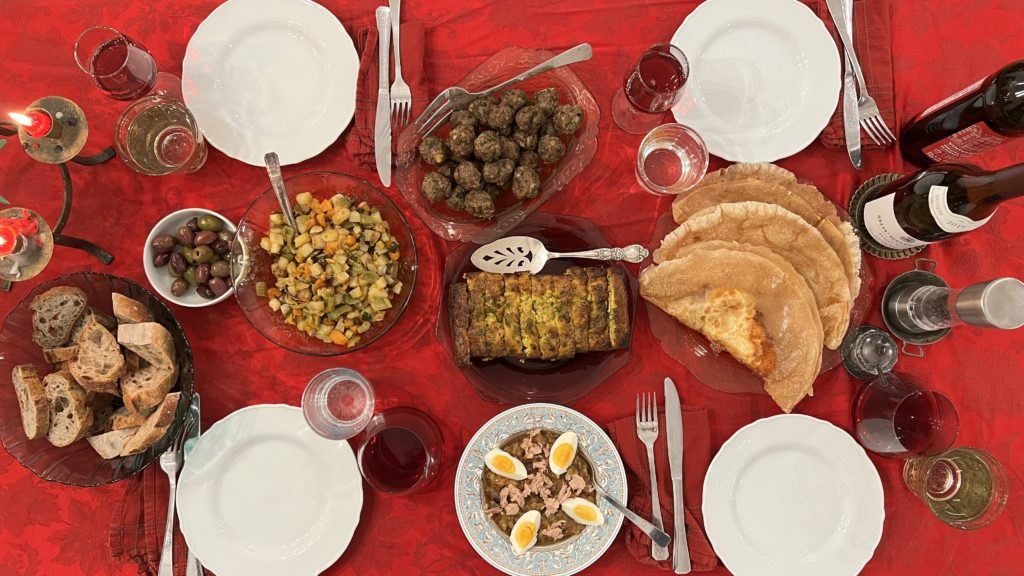Our weekly “À Table”dinner series gets its name from the mealtime call to the dining table. Since 2018, we have invited friends new and old to share a meal focusing on food, music and traditions from various places in the Francophone world. It has proved to be a fun way to connect with friends and practice our spoken French. Here on our site, we share portraits of some of our favorite meals so that you can easily do a version of the same chez vous Bon Appétit!
All the delicious details of a trés grande, home-cooked Tunisian feast, prepared by our friend Asma in March 2020, our last gathering before the pandemic.
story
Asma’s Story + Menu
To this day, the scents of lemon, lime, orange blossom and jasmine transport Asma back to her childhood summers in Tunisia. She can almost taste the memories, sitting against the Jasmine tree in her grandmother’s yard in Tunis, and sipping lemonade perfumed by orange blossom or jasmine.
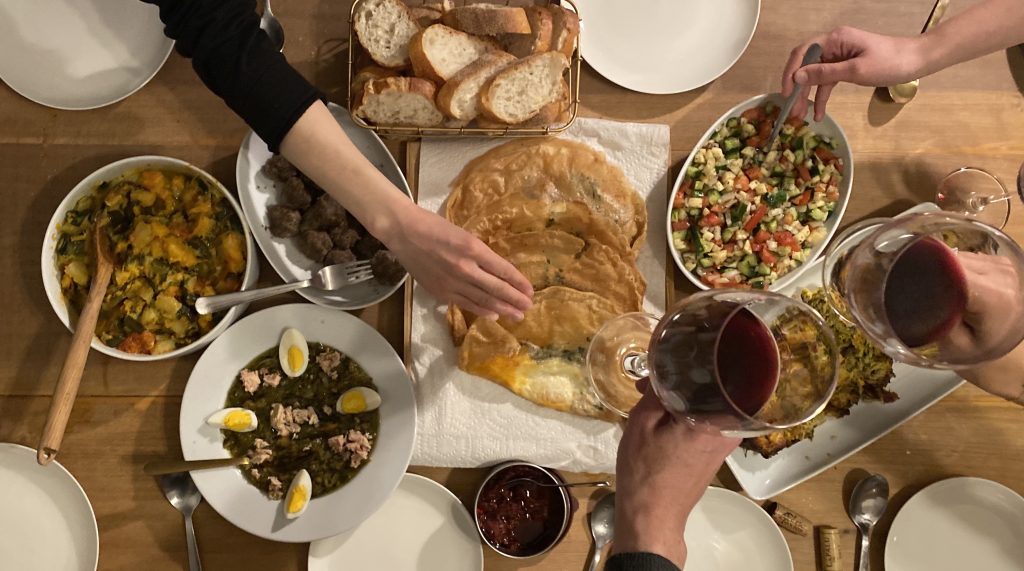
Born and raised in France and trés français, ties with her family’s homeland were also strong. Asma grew up eating mainly Arabic and Tunisian dishes in their Paris home, and Sundays were always couscous. She absorbed so many recipes, techniques and family stories in the kitchen with her mother, and over time also began noting the subtle differences in how her mother prepared her grandmother’s recipes.
Until the age of 16, each summer she found herself back in Tunisia. She relished helping her grandmother peel carrots, potatoes and garlic cloves, and stir tomato sauce. Along with the time in her mother’s kitchen in Paris, these times alongside her grandmother cemented her belief in food as a way of showing love. Out of that, came her love of entertaining and sharing food with friends and family. How lucky were we to be on the receiving end of that delicious love, gathered around her cozy Brooklyn kitchen table, in early March 2020.
Two steps into Asma’s home, before we even made it to the kitchen, I learned my first lesson: never to put my purse or backpack on the floor, lest I lose all my money!
“No! You don’t want to keep your bags on the floor. My grandmother always told me you would lose your money. Even at a restaurant if there is no place for my bag on a hook or over the side of the chair, I’ll keep it on my lap. Better safe than sorry!”

The Menu
Below we have captured the recipes for the dishes she prepared for us, which have have been passed down through three generations. Delicious as they may be, they are not overly difficult! Here was the full menu:
- Kaftaji
- Boulettes Viande
- Slata Mechouyia
- Slata Tounsia
- Tagine Poulet
- Bricks
- Bouza
The Plan
Here is your game plan summary to make this impressive home-cooked Tunisian feast. You will want at least 5 hours for these 7 dishes if it is your first time and will need to keep checking the recipes. An extra pair of hands also helps!
Five hours prior:
- Boil chicken. When cooked, remove from bone and refrigerate until ready to use. This can also be done the day before.
- Set eggs to boil and keep aside when cooked.
- Wash/chop veggies. Dry roast the ones for the Mechouia in your broiler or charcoal grill if you have one), and with oil in a hot oven for the Keftaji.
- Prep the Boulettes Viande.
- Fry the cooked chicken for the Tagine and keep aside.
- Combine and season the veggies for the Keftaji.
- Combine, chop and season the veggies for the Mechouia/.
- Prep the Tagine for cooking, put it in the oven.
- While Tagine cooks, make the Bouza, and put it in its serving glasses to begin to cool. This can also be done before the chicken or the day before to get it out o the way.
- Somewhere in there pop open the wine and toast to yourself for this delicious endeavor.
- Fry the Boulettes Viande and keep aside.
- Chop/prep the Slata Tounisian.
- Prep ingredients for Bricks.
- Chop bread and set table, and put out all dishes and do not forget the Slata Tounisian if you made it early and put it in the fridge (like I once did).
- Fry the Bricks and when they are on the table with the rest of your fest, call out “À Table” to your hungry guests. Enjoy!
music
Emel Mathlouthi
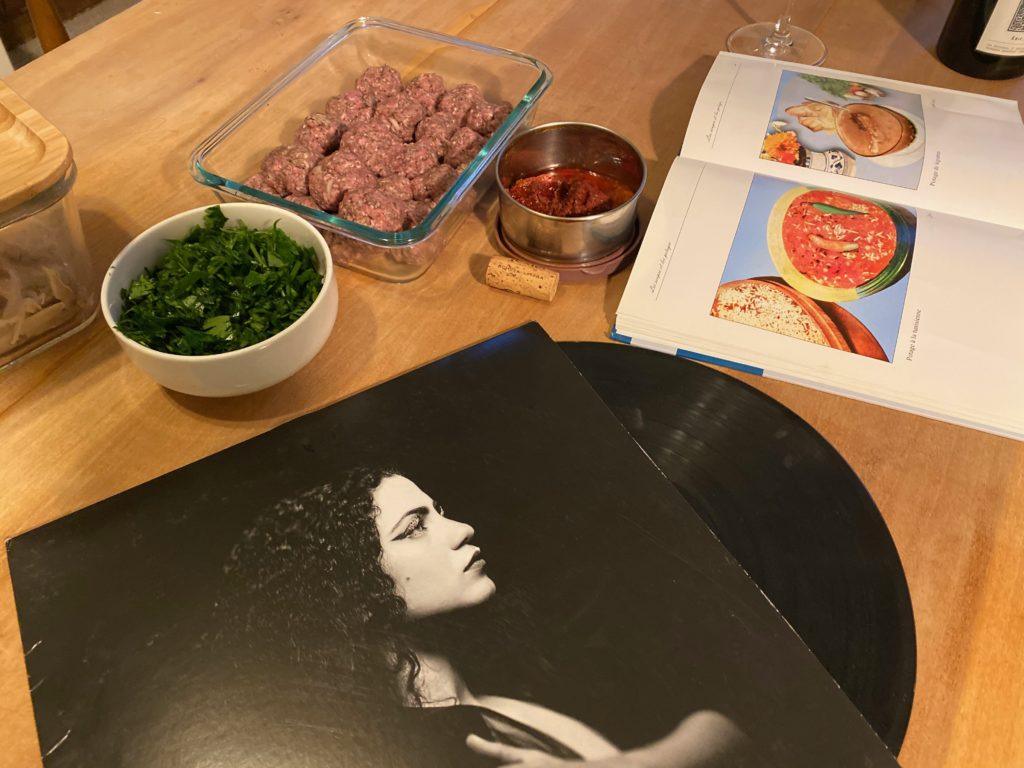
While we were cooking, Asma put on one of her favorite albums on their kitchen turntable (note to self: I want a turntable in my kitchen!): Emel Mathlouthi’s 2017 album Ensen.
More commonly known simply as as Emel, her protest song “Kelmti Hora (My Word is Free)” became the anthem for the Tunisian revolution and then later the Arab Spring. Give her a listen and you’ll be able to feel how her powerful sound helped empowered people to fight for their freedoms.
2022 update: Emel has released a lot more music since we created this playlist so we had to add more. One can’t-miss is her spine-tingling cover of Bowie’s “The Man Who Sold the World,” and another is “Naci en Palestina,” her haunting version of a Greek folk song which she transformed into a dedication to the long-suffering Palestinians.
A lover of lyric and a sucker for translations, we also were happy to find that her website provides her lyrics in English and Arabic for her most recent Album, and in English and French for Emsel.
… also don’t miss the bonus at the end of this post: more about Emel, thanks to the Duolingo French Podcast!
recipe
Slata Mechouia
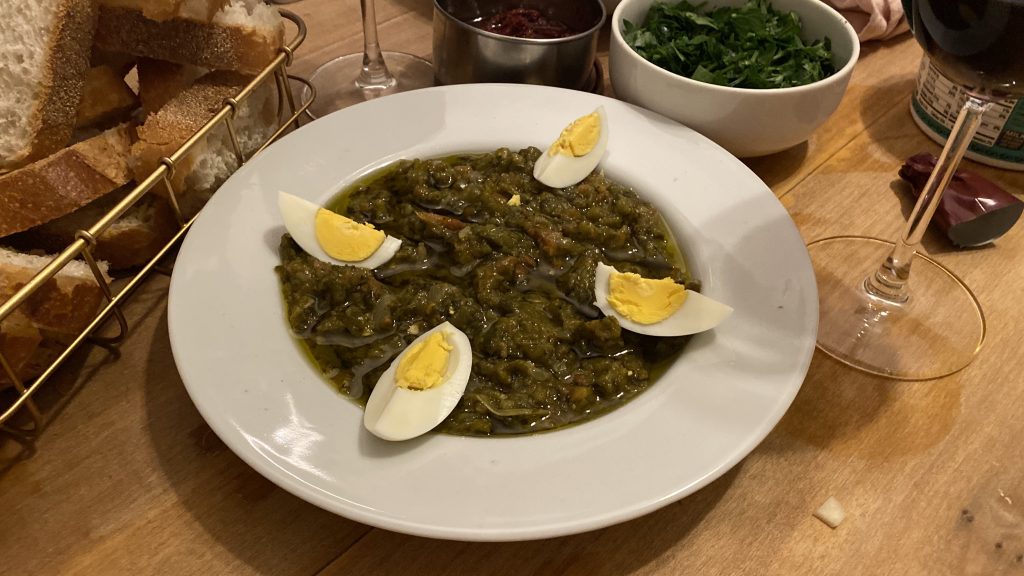
Asma says her preparation of this dish has evolved over generations. While her grandmother would make it the traditionally Tunisian way with spicy green peppers, Asma makes it more as her own mother would, with a less-spicy green pepper. Long, skinny green peppers are preferred, but green bell pepper can be used in a pinch (though never yellow or red bell peppers!).
The most authentic taste will come from two things not easily accessible to many of us: roasting the vegetables over a charcoal grill, and processing the vegetables through a “moulin à legume” [(wind)mill for vegetables] on the large hole setting.
Thankfully, roasting in broilers or super hot ovens (sans olive oil!), and using a food processor (or good old knifes and muscles) will work just fine.
Slata Mechouia (Roasted Salad)
Ingredients
- 2 hard-boiled eggs, quartered lengthwise
- 3 long green peppers, roasted
- 1 tomato baseball-sized
- 1 onion, skin on billiard ball-sized
- 2 tsp tabel + caraway spice mix (1:1 ground caraway seed: coriander powder)
- salt
- pinch chili powder depending on spice of pepper, and spice profile desired
- 1 tsp olive oil at least
- 1 tsp minced garlic
- 3 tbsp canned tuna, in oil
Instructions
- Eggs – Set egg to boil in water if you haven't already. When cooked, allow to cool, peel and keep aside.
- Roast – Meanwhile, preferably over a flame, roast the peppers, onion and tomato until completely black, then put inside a paper bag to allow to sweat. When cool (~20 mins), pull off the skin and put the vegetables in a bowl, or a food processor.
- Pulse – Assuming you don't have a moulin à legumes put the roasted vegetables, spices and olive oil into a food processor. You do not want a puree, so just pulse a few times until combined but still chunky. Adjust salt and chili to taste.
- Serve – Garnish with the sliced hardboiled egg, a bit of tuna and drizzled with olive oil, Serve with slices of fresh bread.
recipe
Boulettes Viande
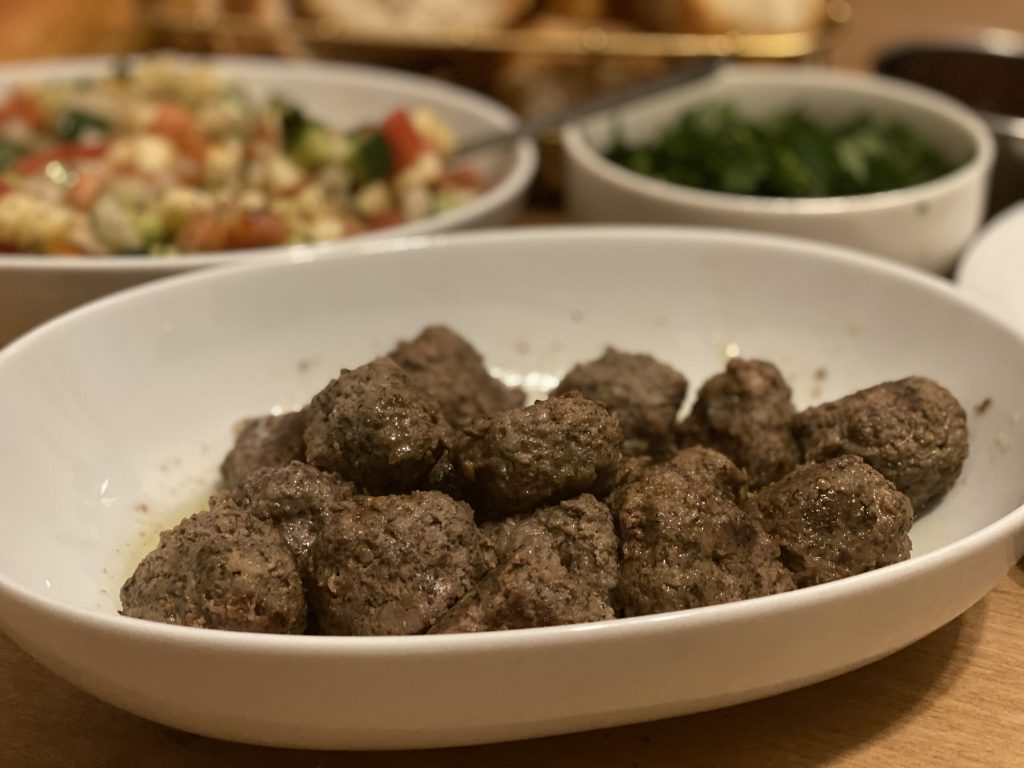
Boulettes Viande
Ingredients
- 1 lb ground lamb
- 1 cup onion, finely diced
- 1 egg
- 1 cup breadcrumbs
- 1/2 cup fresh mint, finely chopped
- 1 cup fresh parsley, finely chopped
- 1 tsp salt
- 4 tbsp vegetable oil for cooking
Instructions
- Prepare meat – In a large bowl, mix all ingredients except vegetable oil. Hands work best, but don't forget to remove your rings first!
- Shape – Shape meat into golf-ball sized balls, to allow to cook evenly. Keep chilled until until 15 minutes before cooking.
- Cook – When meatballs have come to room temperature, put oil in a wide fry pan, and set heat to medium-high. When hot, put in half the meatballs (or as many as will comfortably fit in your pan without overcrowding). Allow to cook turning every so often to ensure even cooking, all the way through. When cooked, put on a paper towel-lined plate temporarily to absorb any extra oil.
- Serve – Serve warm or cold, even the next day. Best alongside the rest of the vegetables in Asma's Tunisian Feast.
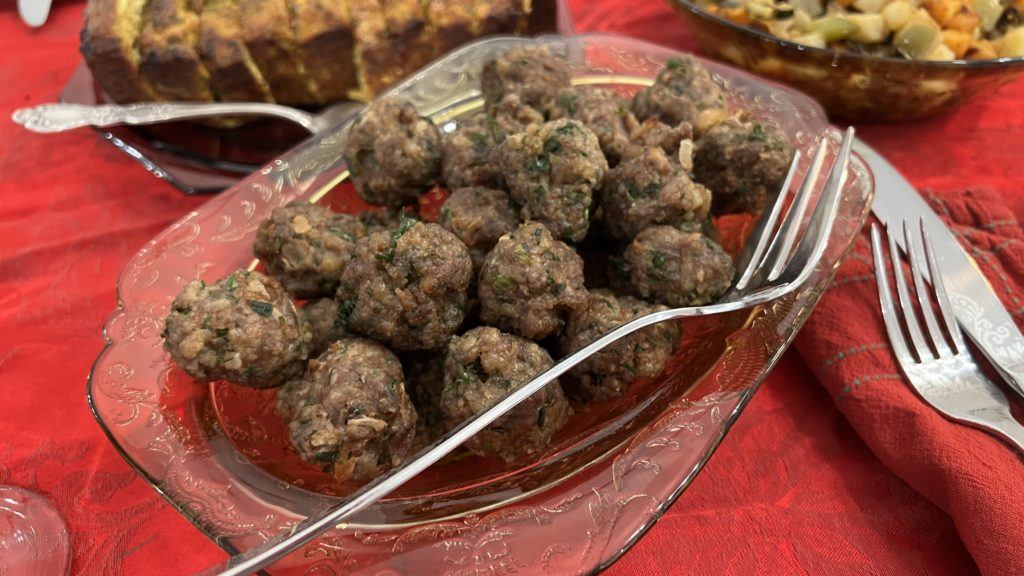
recipe
Tagine Poulet
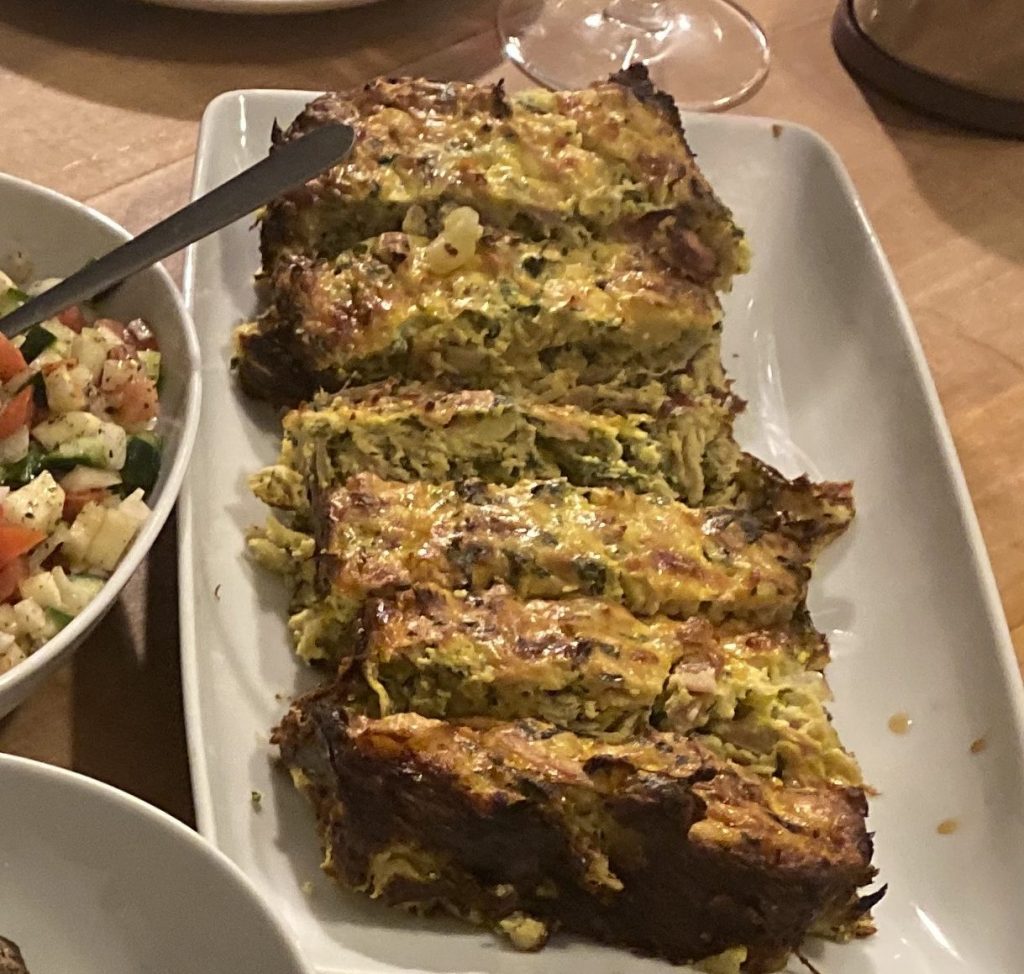
This dish came about as a way to use leftover chicken. It’s name may make you think of the Moroccan dish and cooking pot, but it is actually more like a frittata or crust-less quiche. To further distinguish it as it’s own incarnation however, note that it is always made in a loaf pan (unlike its rounded frittata/quiche counterparts).
A filling dish that is good for a crowd, it is often served at funerals in Tunisia. Asma has memories of the family of the deceased making enough to feed the whole village as a way or memorializing the deceased at the time of their burial.
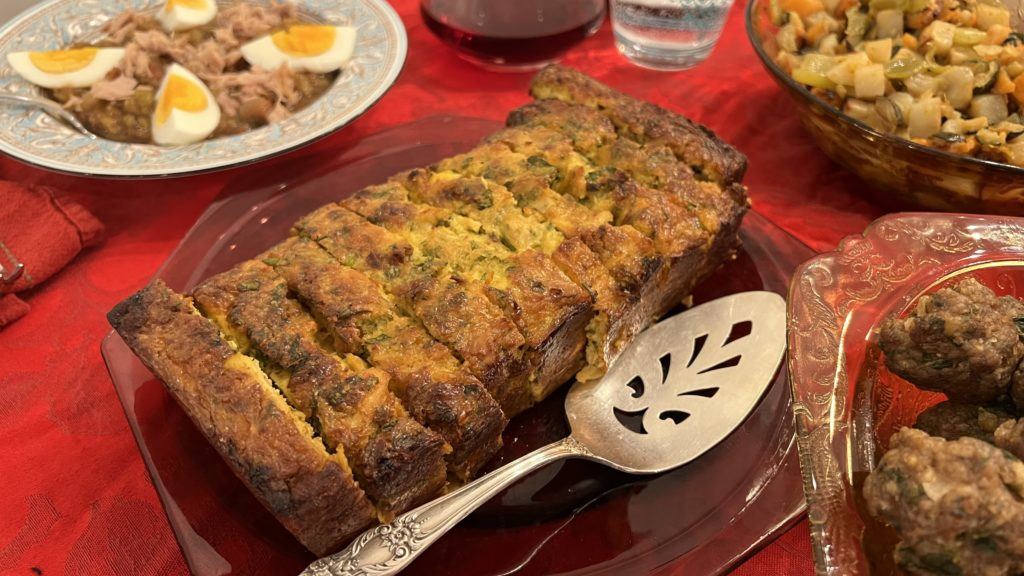
Tunisienne Tagine Poulet
Equipment
- bread pan is traditional
Ingredients
- 2 cups loosely-packed parboiled chicken, shredded
- 1 cinnamon stick optional
- 1 1/2 cup diced yellow onion
- 2 tsp tabel + caraway powder (1:1 ground caraway seed: coriander powder)
- 1/4 tsp turmeric
- 1/2 cup chopped fresh parsley, tightly packed
- 3 tbsp olive oil
- 8 eggs
- 1 tsp salt, divided
- 1 cup shredded mozzerella
Instructions
- Parboil Chicken – Set a pot of water to boil, with the chicken and a cinnamon stick. When cooked through, shred the chicken and keep aside, discarding any bones/cartilage/fat or save for more chicken soup/broth!).
- Fry Chicken – Heat a large frying pan on medium heat. Add oil, and when hot, add the onion. Stir to combine and continue to cook until very golden brown. Add spices, stir and fry for a minute or two. Add chicken and stir to combine, continue cooking until chicken becomes well-fried and takes on the flavor of the onion and spices.
- Prep + Cook Tagine – In a large bowl, beat the eggs and add the chicken mixture to it, combining well. Pour the mixture into the a bread pan, and cook until a toothpick comes out clean (about 30 minutes).
- Serve – Allow to cool for 10 minutes, then remove from pan and cut into 2cm wide slices. Serve with fresh baguette, or cold, even a day later. Makes a nice sandwich on a baguette with slata mechouia.
recipe
Keftaji
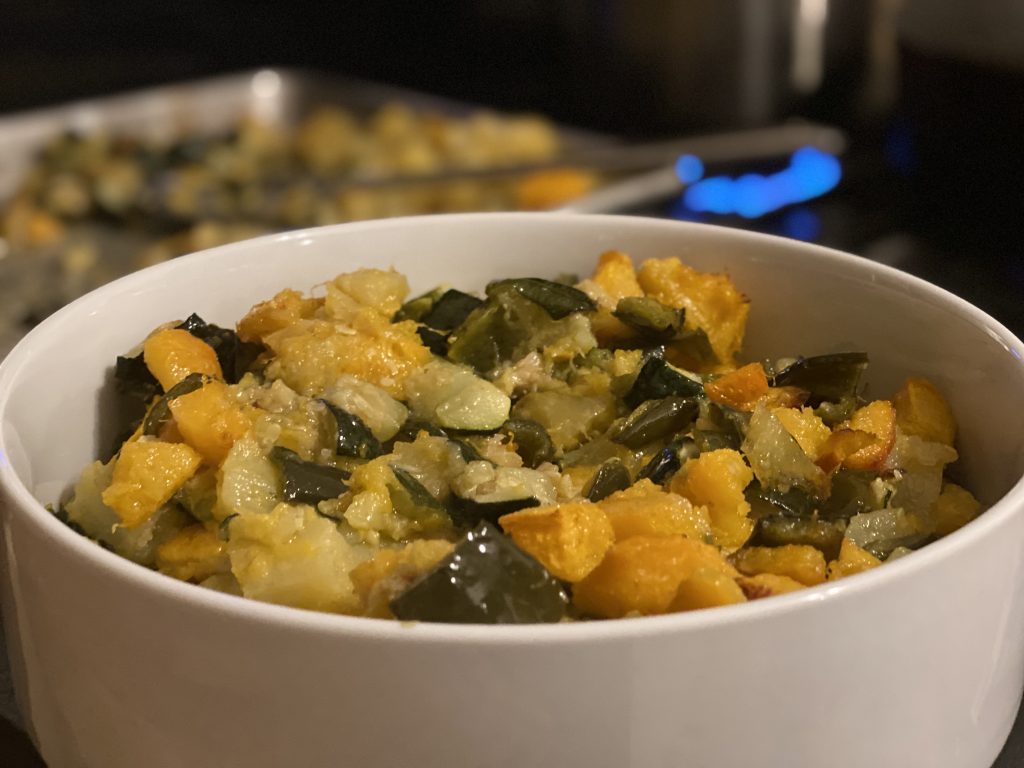
This could be described as a Tunisian ratatouille. It is delicious fresh and warm, or even the next day, cold or warm.
Keftaji
Ingredients
- 4 small zucchini, cut into 1/2 inch cubes
- 1 butternut squash, cut into 1/2 inch cubes
- 3 green peppers, cut into 1-inch pieces
- 2 russet potatoes, peeled and cut into 1/2 inch cubes
- olive oil, plenty for roasting and serving
- "tabel + caraway" spice mix (1:1 ground caraway seed: coriander powder)
- salt
Instructions
- Prep – Preheat oven to 450F. Wash dry and peel the vegetables (peeling zucchini is optional). Chop into cubes, and arrange each vegetable in single layer on its own separate rimmed baking sheet or pan. Exact amounts of vegetables are not critical, but you can expect to want to have a very full quarter sheet pan worth of zucchini, butternut squash potatoes, and a scant sheet pan worth of peppers . Drizzle each with olive oil and toss to combine.
- Roast – Roast the vegetables for about 30-40 mins (depending on the vegetable) until browned just a bit, stirring twice. When done, remove from heat and allow to cool.
- Serve – When cool, put all of the roasted veggies into a bowl large enough to toss well, add salt and table + caraway, and a bit of olive oil. Taste, adjust seasoning, and it's ready to serve.
recipe
Slata Tounisiya
A very typical and traditional Tunisian salad that is a wonderful compliment to the rest of this home-cooked Tunisian feast.
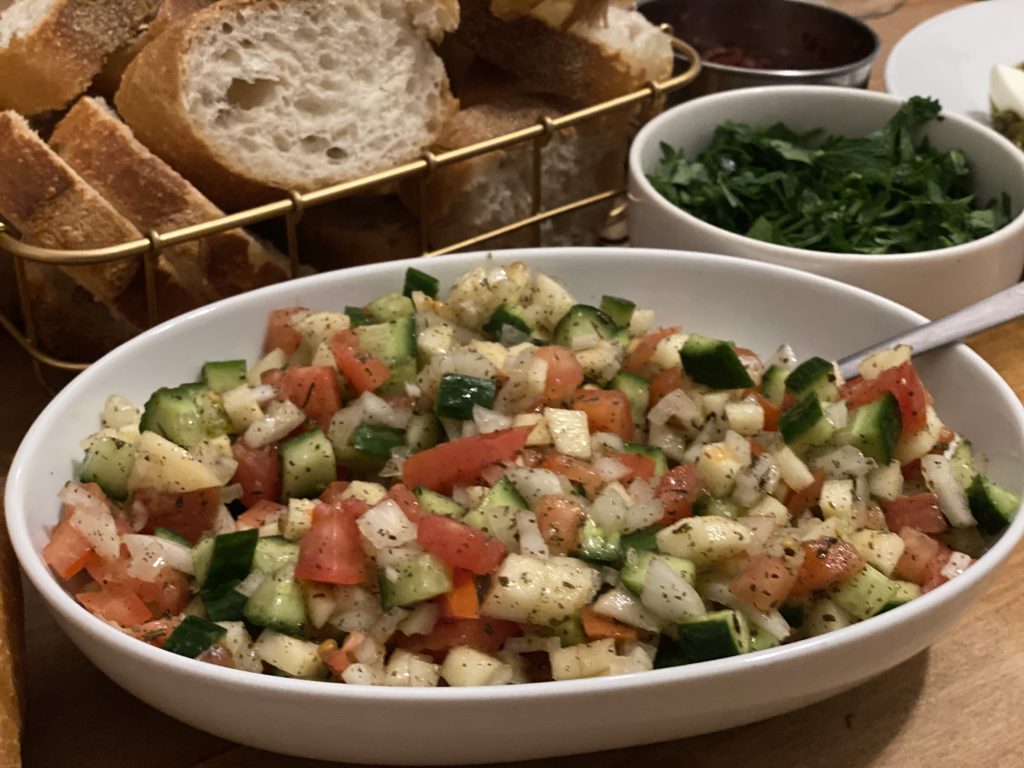
Slata Tounsiya
Ingredients
- 1 cup apples, diced (about 2 small)
- 1 cup tomatoes, diced (about 2 small)
- 1/2 cup onion, diced
- 1 cup cucumber, diced
- 1/2 cup long green pepper, diced optional
- 2 tbsp fresh lemon juice
- 2 tbsp olive oil
- 2 tbsp dried mint, chopped fine and loosely packed
Instructions
- Wash and dry the fruits and veggies, and peel the apple.
- Chop apple, cucumber, onion and tomato in a similar-sized small dice, collecting all into a serving bowl large enough to fit and toss it all. If using, chop pepper and add to the same bowl
- Add olive oil, lemon juice, and dried mint, and toss to combine. Serve immediately, or keep in the fridge up to an hour, until ready to serve
recipe
Tunisian Brick
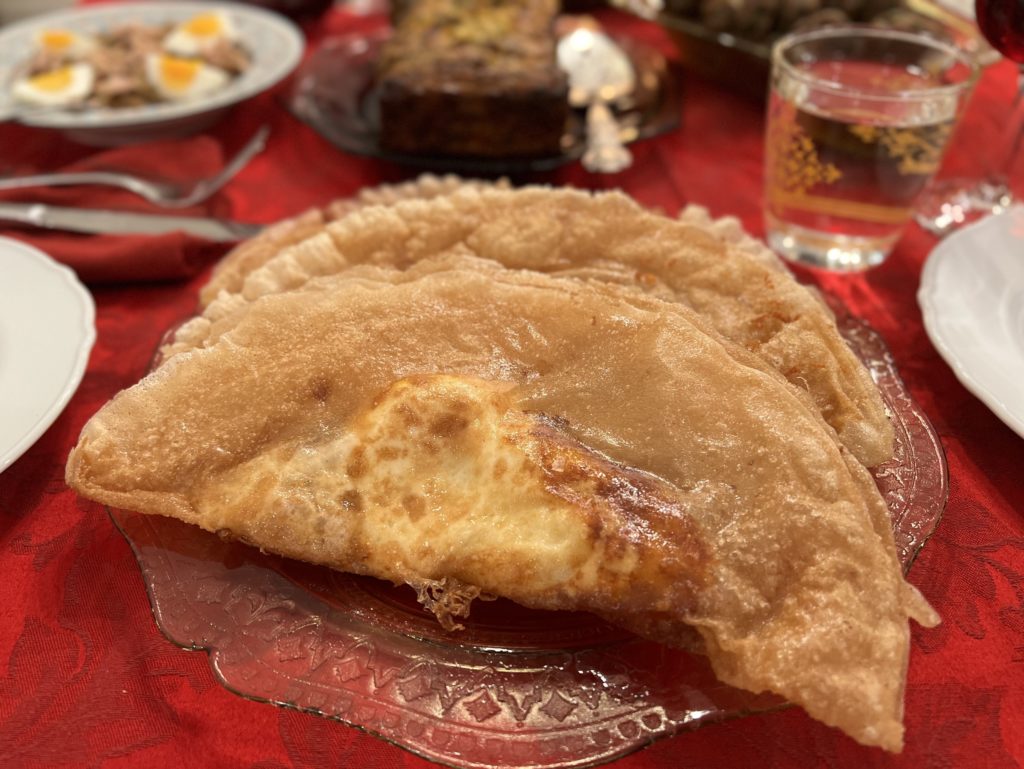
When her kids were young, Asma dubbed a “Tunisian taco.” It was the sort of temporary rebrand that savvy parents often engage in order to tempt kids into something they aren’t sure will be as appetizing to the kids as they are to the parents.
Whether it was the rebrand or just the knowledge that it was fried dough filled with deliciousness, my kids also fell for the deliciousness that is the Tunisian Brick.
A crispy fried outer shell, with a unique combo of flavors inside, including a bit of runny yolk, this is quite a treat. Below is a video of Asma making it for us the first time we enjoyed it in early 2020.
Asma also uses these bricks (the name both for the paper-thin, round dough that you can find in the freezer of Middle Eastern stores, and the recipe below), to make “cigars.” I’ll have to look into the story with that rebrand (which likely wasn’t for children!), but you may recognize the term as the long, (and admittedly “cigar-like) skinny meat-filled pastries available in many North-African restaurants. She bakes her cigars to be a bit more healthy and also easier than standing over the hot oil frying them in batches. That’s a recipe for a different day!
Tunisian Brick
Equipment
- large, wide frying pan
Ingredients
- 10 frozen bricks likely 1 package
- 1 can albacore tuna, in water
- 1 cup chopped parsley, loosely packed
- 1 cup shredded mozzarella cheese
- 10 eggs (one per brick)
- vegetable oil for frying
Instructions
- Prep – Open a can of tuna into small bowl, breaking it into small pieces. Have all ingredients ready next to your stove so that you can quickly arrange the fillings for each brick.
- Cook Bricks – Heat oil in a large frying pan over medium heat. When hot, put in one brick, quickly add filling mostly onto one half of the brick, careful to leave about a 2 inch margin at the edge. Then use tongs to fold over the empty side. Allow to the edges to cook together then carefully flip to cook through to the other side. You don't want the egg to cook through. You want the yolk to ooze out and meld with the other flavors.
- Serve – Enjoy these immediately, warning guests to be careful not to burn their tongues!
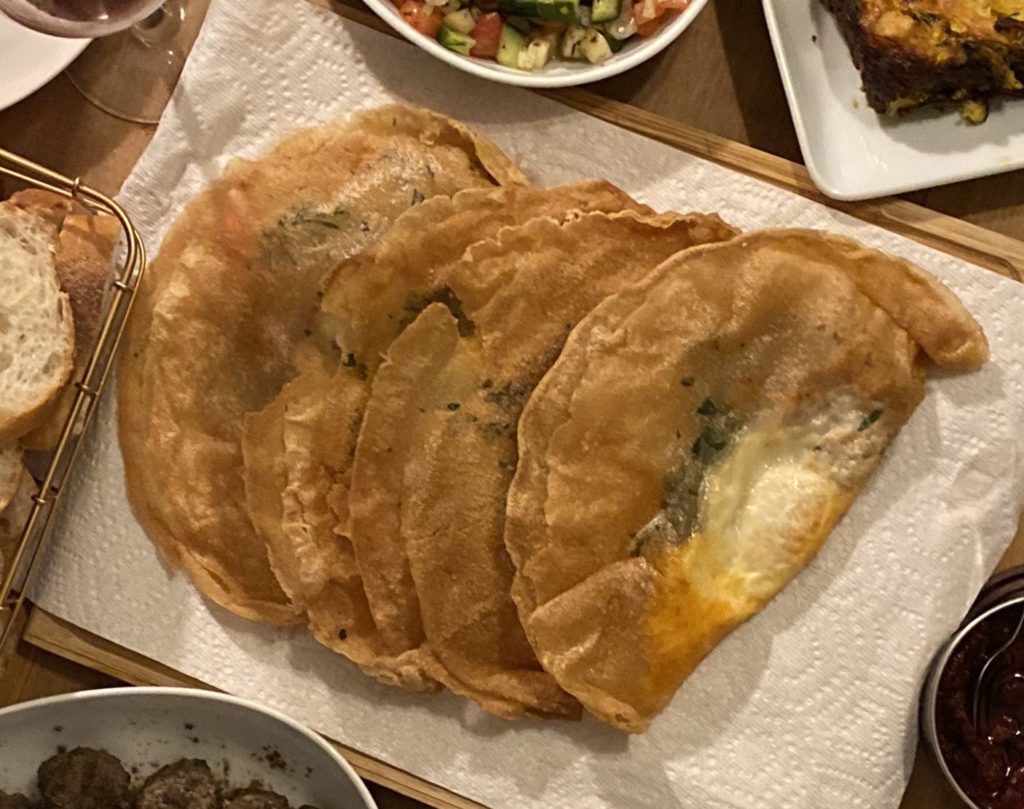
story
Bouza aux Noisettes
A dessert originally served to royalty, this hazelnut mousse is a delicious way to wrap up your Tunisian feast.

Note that you may need to plan ahead because hazelnut paste can be hard to find (all the usual go-to spots in Brooklyn have been out for years), but Amazon has it. You can also make your own paste, but we didn’t this time.
Bouza
Ingredients
Bouza aux Noisettes
- 3/4 cup hazelnut paste ~150g
- 7 oz condensed milk 1/2 can
- 3 cups reduced fat milk
- 1 1/2 tbsp corn starch
Garnish (optional)
- Fresh whipped cream with rose water
- chopped pistachios or hazelnuts
Instructions
- Gather heat + cold safe serving glasses/cups. You don't want to crack your glasses when the hot cream comes out of the pan, nor when it goes into the fridge!
- In a medium saucepan, add the milk, condensed milk and hazelnut paste. Set the heat to medium and whisk constantly to combine.
- When warmed through and well combined, add the corn starch and continue to whisk constantly, for about 10 minutes, until it thickens a bit. Note that it will continue to thicken as it cools.
- When at desired consistency, turn off the heat and allow to cool slightly. Pour into individual serving glasses and put in the fridge to chill for an hour or more.
Serving
- After the creme has chilled and you are ready to serve, add whipped cream / crème anglais desired), and top with chopped nuts hazelnuts, pistachios or both!).
- Serve chilled and savor it, feeling like royalty.
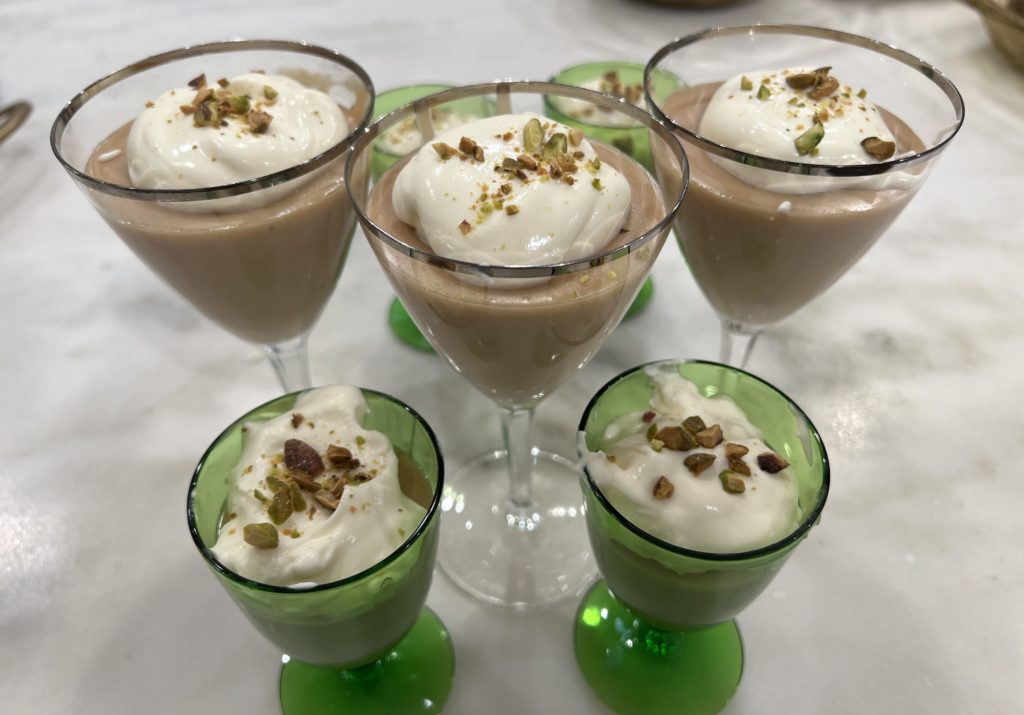
Bonus
Listen to Emel’s Story, in French
Thanks to Duolingo, you can listen to Emel Mathlouthi speak about how her music came into the world and what impact it had, near and far, all while practicing your French listening skills.
Episode 22: Une chanson révolutionnaire (A Song of Revolution)
Duolingo French Podcast
The always inspiring and fascinating Duolingo French Podcast has an episode which features Emel Mathlouthi: Episode 22: Une chanson révolutionnaire (A Song of Revolution).
For another portrait to pair with an episode, head to the “Poulet en Soupiere + Jacques Brel.”
